Sometime in the middle of October I threw this silk top at the daughter to hand (No. 3) and rushed her outside to take some photographs while the weather was amenable to thin top wearing. Unusually foresightful for me, I must have had an inkling that early December would be pulsating with the panic induced by half finished Christmas projects, the tail end of a flu-like virus (which sits incubus-like in the throat, alternately robbing you of speech and the ability to swallow) and the imminent appearance of a baby (a grandchild, not to mention the Christ child). To be quite accurate, it is true, that I did know about both the babies in advance.
Thus was I drawn magnetically via thoughts of literary roses and winter comfort-reading to Lynne Truss’s ‘Tennyson’s Gift” which is the funniest book I have ever read and which opens with the memorably incongruous scene of red garden roses being painted white. Though well reviewed when it came out in 1996, initial sales only amounted to about 2,000 copies – and I must have brought half a dozen of them as they were my standard issue Christmas present for that year. Then there was a big G.E.Watts exhibition at the National Picture Gallery about 10 years ago and I made inroads into another stack of books on sale there. Yet, strangely, I never seem to have a copy to hand for myself and when the mood to read it again tsunamied over me recently, I had to borrow back the copy I’d most recently given away. I was not disappointed. The book still works its magic and has me spluttering out loud with ill-suppressed joy – h0w can you not when someone describes Tennyson as “the greatest wordsmith in the land, the man who claims – with justice – to know the rhythmic value of every word in English except ‘scissors’. The man who had the extraordinary literary luck to write In Memoriam before Queen Victoria got bereaved and needed it.”
I have to admit here that I am not much taken with Tennyson’s poetry. This is a dodgy position to hold for various reasons, none of which I shall bore you with, except to note that Balliol has amongst its fellows an eminent Tennyson academic who is also the Library Fellow and who has written at least one excellent article about the poet that I have actually read (TLS a couple of years ago, I think). Where Tennyson is concerned, the fact is that I’m rather ignorant. But, away from depressing revelations of inadequacy and back to the laugh-out-loud joys of Lynne Truss’s book.
July 1854 finds the Isle of Wight awash with what we would now call celebrities. This handful of eccentric Victorian luminaries, penned up in their little corner of the island, find life a series of emotional fairground rides powered by love, desire, high art, poetry and just a bit of low cunning. (Italics indicate quotes from the book)
Julia Margaret Cameron’s house, Dimbola Lodge, is a riot of activity. In a garden where spoilt photographic plates lie abandoned and broken in the shrubbery and where bushes are as often found bearing biblical or medieval costumes as flowers, the painting of red roses white should come as no surprise, especially to a rather creepy Charles Dodgson who just happens to be worming his way up the lane outside. Dodgson (Lewis Carroll) “a clever dysfunctional thirty-two-year old, middle-aged before his time, whose own singular insights and private jokes are his constant source of intellectual delight” had already written Alice, although it had yet to be published. “To someone who has only recently completed ‘Alice’s Adventures in Wonderland’, this scene came as a bit of a shock, obviously.”
Dodgson has come to the island to cement an acquaintance with the Poet Laureate, Alfred Tennyson, a man whose eminence is tempered by an extreme sensitivity to suggestions of the association of genius with madness. As is quite usual, the pillar supporting this literary eminence is a thin, sharp-eyed woman – his wife. Emily – “…one of those invalids who … sometimes can’t lift a bread knife, but can shift a mahogany wardrobe if the fancy is upon her to see it in a different place.” Emily does her best to keep bad reviews from her husband and to do this, she often has to resort to activities that border on the madness that her husband fears for himself and his sons. A parody of ‘In Memoriam’ in Punch so panics Emily that she tears the page out of the magazine, stuffs it in her mouth and begins to masticate, wondering when questioned whether her“anaemia craves the minerals in the ink.”?
Meanwhile, at Dimbola Lodge, G.F. Watts (middle-aged portrait painter of ponderous classical and biblical heroes and general cuckoo in the nest of any society hostess who desires him to grace her salon) and his 16 year-old bride, budding actress, Ellen Terry are coming to grips with married life (although that suggests closer physical entanglement than they have yet managed). In between bouts at his easel, Watts has a tendency to indolence and a natural affinity to the comfort of over stuffed Victorian sofas. Ellen, “found it odd to be married to a man so attached to the horizontal, when her own body sang with energy, vigour and bounce.” Both Tennyson and Watts leave her with little patience concerning the inconvenience of artistic creation,“It was whisper-of the-Muse time – all very worthwhile and pretty on a clifftop with a poem coming on; not so useful if you were racing for an express.”
Dimbola’s hostess and Victorian photographer, Julia Margaret Cameron, is the one plain daughter in a family of beauties. A vortex of unmeditated action, hair corkscrewing from errant hairpins, hands and clothes stained with photographic chemicals, she is, however in possession of a beautiful soul. Charles Cameron’s summary of his wife is touching, “she is a strange woman. … But I would not exchange her for all the cracked pots in Staffordshire.” On a practical level, Julia also prides herself on giving the best adulation in England. Dinner parties were, “a bit like spinning plates. With an initial effort, she would get all her guests spinning individually and then – when they started to wobble or flag – they required just a practised touch at the right moment.” Julia has a deep spiritual love for Tennyson and desires nothing more than to have him sit before her and be photographed. To this end she showers the Tennysons with gifts and performs all sorts of little actions which she believes to be kindnesses. The roses are painted white as a Valentine to the poet for in the language of flowers, a white rose means ‘I am worthy of you’. Silks, cushions, inlaid boxes and sideboards are sent but by far the most wonderful of her presents are the 6 rolls of bright blue wallpaper decorated with a frieze of the Elgin Marbles, which, in true farce style reappear not once but twice in pivotal moments of plot, the second one of which provides the book’s climactic, heroic and utterly ridiculous highpoint.
Into this already heady brew, appear an American showman phrenologist and his precocious daughter. Lorenzo Fowler and Jessie, both historical people, were indeed performing to the great British public at this time, but try as she did, Lynne Truss could never place them on the Isle of Wight. The Fowler’s ersatz science gently touches all the main characters and provides much ironical amusement – in just the same way that reading horoscopes is both fascinatingly accurate and utter tosh at the same time. Thus Ellen cogitates on the phrenological analysis of the bumps on her head, knowing that she “had no need to throw caution to the wind… (which) was so naturally small it had been lost in a light gust at birth.” Fortunately, it was no small solace that “she has phenomal hope”.
Operatic in plot, there are many duets, trios, quartets and the like in which lines both spoken and unspoken reveal an underlying subtext. Lovely girls of lowly backgrounds with problematic amounts of glorious hair often express more good sense than old men with tangly hair and beards. A girl dresses as a boy and catches a maiden’s eye. Among the minor characters a mad ax murderer bides her time. Those who have spent half a life waiting for Queen Victoria to visit are distracted by a garden subplot and return to find the Queen has been and gone and taken with her a small pamphlet describing the glory of sexual frenzy. Such is life. Hilariously funny, touchingly moving and wise, the book is a triumph of history as it never happened but should have done. Rush out and buy the book and give yourself the best tonic ever.
Interesting note: Julia Margaret Cameron was the aunt of Julia Stephen (née Jackson), who was Virginia Woolf’s mother.


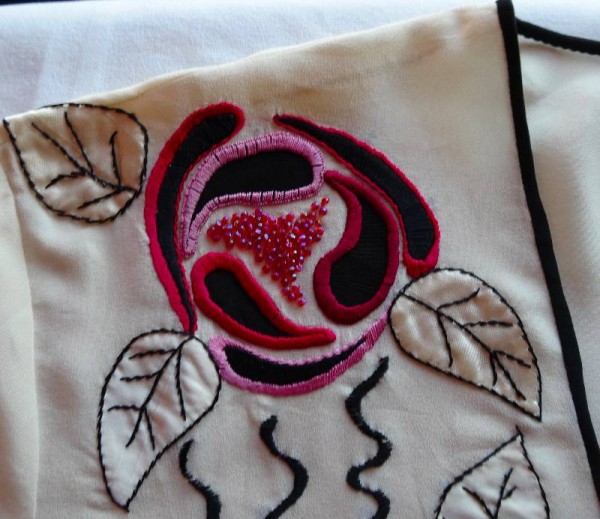
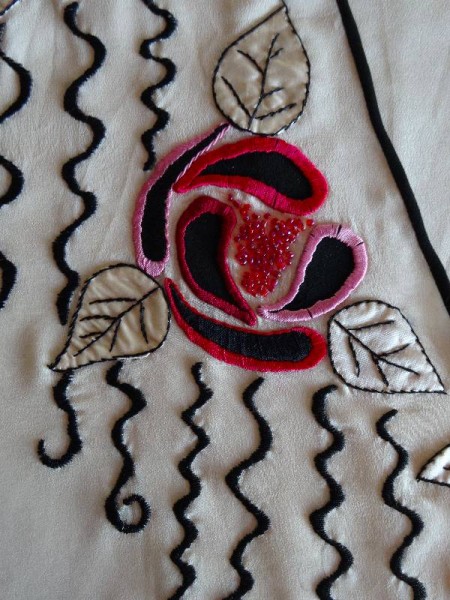
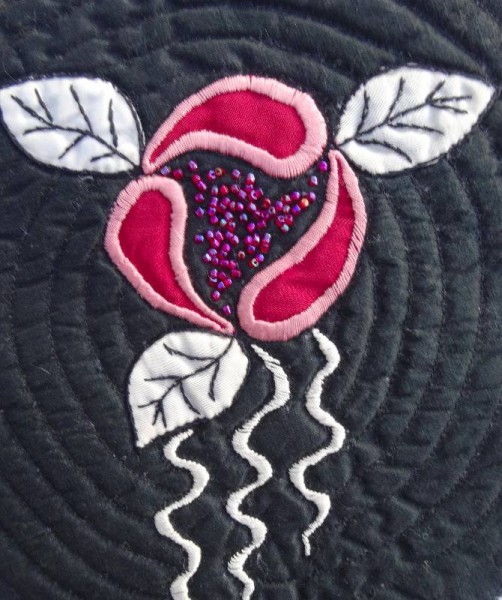
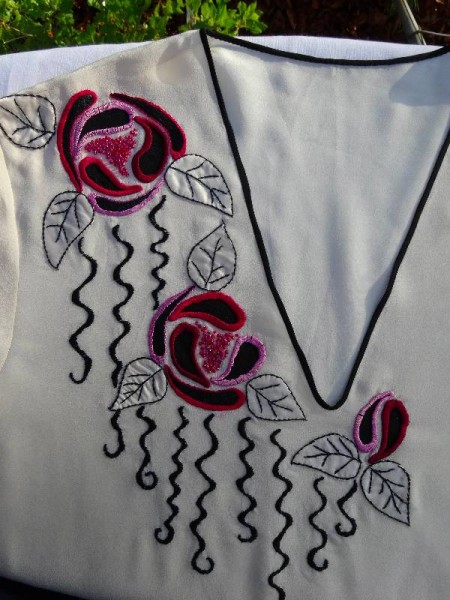
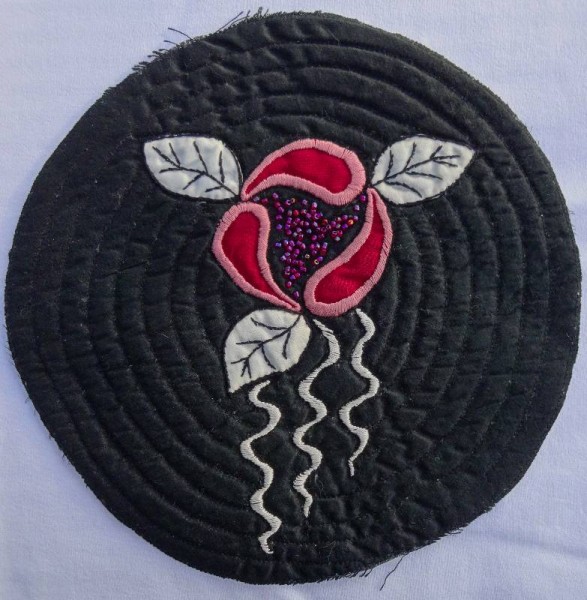
2 Comments
Your beautiful embroidery and fun book review inspired me to look for Tennyson’s Gift’. While I am a true lover of a real book, I did find this in a Kindle version. So I’m now ready for some enjoyable winter reading…along with my knitting. Thank you!
Oh Claudia, I do hope you enjoy ‘Tennyson’s Gift’ even just a fraction as much as I do. Thank you for your lovely comment.
One Trackback
[…] literary luck to write In Memoriam before Queen Victoria got bereaved and needed it.” (see blog Lynn Truss’s book ‘Tennyson’s Gift’ – a definite for the boudoir shelf and I’m pretty sure the funniest book I’ve ever […]